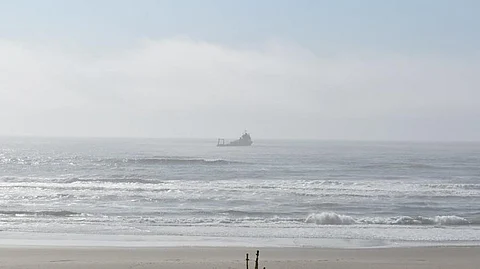

Crews will soon begin installing the power and data cables necessary to complete construction of a new wave energy testing facility off the Oregon Coast.
The cables will support Oregon State University’s PacWave South, the first pre-permitted, utility-scale, grid-connected wave energy test site in the United States. When the facility is completed, wave energy developers will be able to test different technologies for harnessing the power of ocean waves and transmitting that energy to the local electrical grid.
“Transmitting power from wave-energy generators to shore in a form compatible with the regional power grid is a huge challenge, and cabled connection from PacWave South provides the capability to test power-delivery technologies,” said Burke Hales, PacWave’s chief scientist and a professor in the OSU College of Earth, Ocean, and Atmospheric Sciences. “These cables are highly specialised and their installation and burial is a keystone of wave energy development in the U.S.”
The work includes installing four power and data cables ranging in length from about 10 to 13 continuous miles from a vault under the parking lot of Driftwood Beach State Park south of Newport out to the test site offshore.
Louisiana-based subsea cable services contractor RT Casey is overseeing the installation of the cables. The work will be carried out by crews aboard three vessels and is expected to take six to seven weeks, depending on ocean conditions, said Dan Hellin, Deputy Director of PacWave.
The cables will be anchored in an underground vault at Driftwood and will run through conduits from the shore under the beach, then come up out of the seafloor about 1 mile out. From there to the test site, the cable will be buried about three feet under the seafloor.
The subsea cables, which were manufactured in Norway by the Paris-based firm Nexans, were transported via freighter to Louisiana and transferred to the OSV HOS Innovator, which will be used to lay the cables, to make their way to Oregon.
Once the work begins, a second vessel, the Nautilus, will follow behind to bury the cable using a remotely-operated vehicle. Those two vessels are expected to work around the clock for the duration of the installation, Hellin said.
A third vessel, Liberty, will support diving operations during the cable installation and provide other assistance as needed. That vessel will make trips back and forth from Newport while the work is underway.
On land, another group will be installing cables that run from the vault to a shoreside utility connection and monitoring facility on the east side of Highway 101 just south of Driftwood. Two of the three buildings at the site are nearly completed and the third is a couple of months behind them, Hellin said.
The first wave energy developer is expected at PacWave South in 2025 and the first cable-connected test is expected in 2026 under current timelines. PacWave South is supported by grants from the US Department of Energy, the state of Oregon and other public and private entities. Oregon State’s College of Earth, Ocean, and Atmospheric Sciences is managing the construction and operation of the more than $100 million facility.
